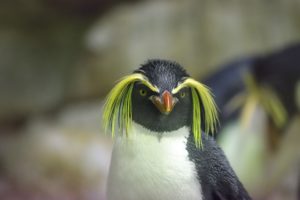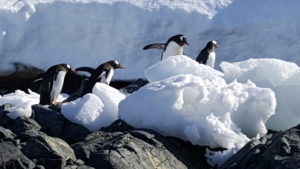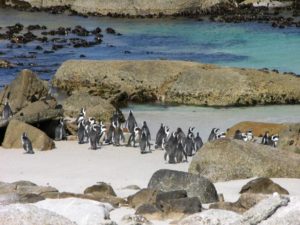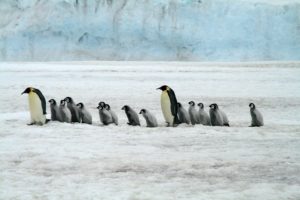What do Antarctica, South Africa, South America, Australia and New Zealand have in common? You’d think there’s not much linking these countries to one another. They aren’t similar in size, the people who live there don’t all speak English as their first language, they don’t even have the same climates. There is, however a small, unassuming, mostly black and white commonality that lives on the shores of these landmasses, marching to the beat of their own drum.
Penguins. There are 18 species in the world and they live almost exclusively in the Southern Hemisphere, with one species, the Galapagos Penguin, living just north of the equator. They are black on their backs to help camouflage them from the predators above and white on their bellies to help camouflage them from the predators below. They are flightless, but that does not stop them from zooming through the waves, sliding down the ice and having fun. Why are we talking about penguins on a travel blog? Well, at The Great Canadian Travel Group, we have many tours that can take you to see these wonderful creatures!

Who is a penguin’s favourite Aunt? Aunt Arctica, of course! So, let’s start there. Our consultant, Allison, went on an expedition cruise there November 2017 and loved it. You can read all about it in her blogs. Out of the 18 penguin species, seven of those live on, or near continental Antarctica. The largest of all penguins, the Emperor Penguin is the most southerly of all species. Then you have the Adélie Penguins who are loud and obnoxious and smelly (they tend to um, go number 2 where ever they are, and it doesn’t seem to bother them). With the Chinstrap Penguins and the Gentoo Penguins (the most northerly of the Antarctic species), that makes up the four true Antarctic species. King Penguins (who rival the Emperor Penguin in size), Macaroni Penguins (don’t put ketchup on them) and Rockhopper Penguins (the smallest of the bunch) are considered sub-Antarctic species, those whose furthest south is the sub-Antarctic islands.
These birds have adaptations to keep them warm in the cold Antarctic climate. One of the most important things they teach us is to dress in layers. Their feathers act as insulators. The fact that they like to huddle close to each other doesn’t hurt either.
Some of the above species like in the Falkland Islands, which technically would be considered South America, not Antarctica, but they do also find themselves close to the seventh continent. The Galapagos Penguins live, you guessed it, on the Galapagos Islands. South of them, on the western coast of South America, from mid-Chile north to Peru, you will find the Humboldt Penguins. Magellanic Penguins live in the south cone of South America in both the eastern and western coasts (about mid-Chile to Tierra del Fuego and then north to south Argentina).

Where to next? Well, let’s talk about the African Penguin. We have lots of tours that go to the south-western coast of Africa, namely Namibia and South Africa. It is the only penguin species that breeds in Africa, living in colonies on 24 islands (aptly named the Penguin Islands), and on the mainland near Cape Town and in Namibia. Boulders Beach in Cape Town is a tourist attraction (for the beach, swimming and, of course, the penguins). Because of this, the penguins will allow people to approach them, however, it shouldn’t have to be said, but I will anyway, these are still wild animals. Please do not feed them or take them home with you. They are in their territory, you are visiting. Treat them with respect.
Little Penguins, often called Fairy Penguins, are the smallest of all penguin species, standing approximately 33cm (12.9 in) tall and weigh around one kilogram (2.2lbs). These little critters can only be found in southern Australia and New Zealand. In Australia, Little Penguin colonies are scattered around the coastline from near Perth on the west coast to Sydney on the east, and then around Tansmania.
Moving south, New Zealand has recorded 13 of the world’s 18 penguin species living on the shores, with nine actually breeding there. The largest mainland colony of Little Blue Penguins can be found on the Banks Peninsula outside of Christchurch on the South Island. This also is home to a species of White-Flippered Little Blue Penguins only found in Canterbury. Yellow-eyed Penguins can be seen just before sunset in Oamaru, dubbed “Penguintown”. Dunedin and the Marlborough Sounds are also home to the Little Blue Penguins. To have a chance to see the world’s second rarest penguin, Tawaki aka Fiordland-Crested Penguin, take a trip to Munro Beach.
What do you call fifty penguins at the North Pole? Really lost, because as you have just learned, penguins live in the Southern Hemisphere. Whatever species of penguins you’d like to see, we have you covered. We can take you to Antarctica on an expedition cruise; we can take you to South America, South Africa, Australia and New Zealand on escorted tours, choose your own adventure tours, and stopovers. Just contact us and we’ll help you plan. Waddle your choice be?








